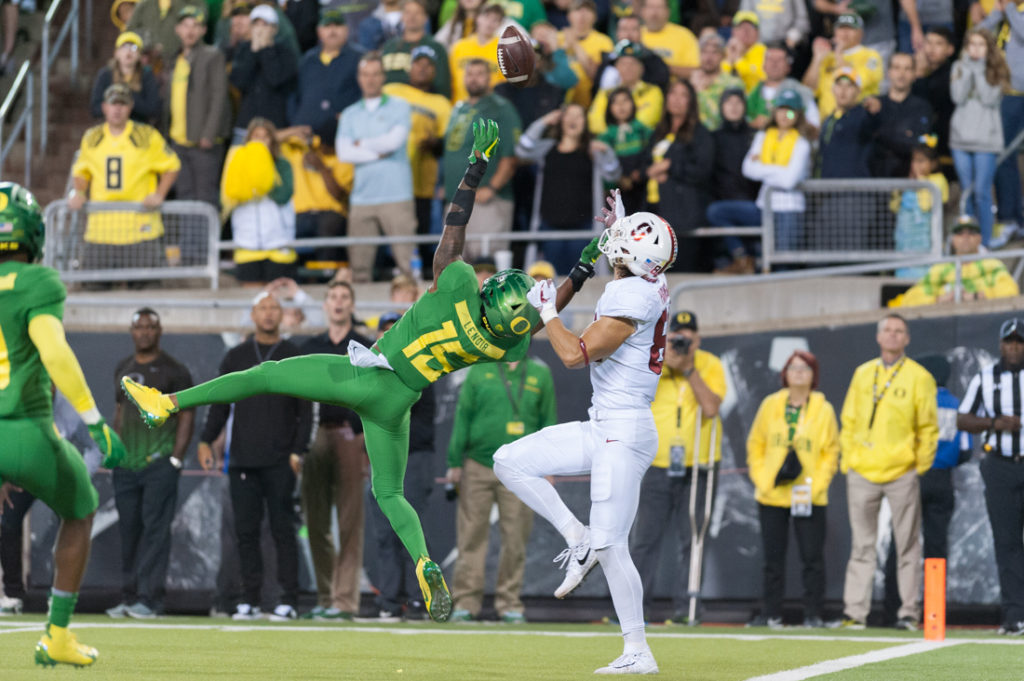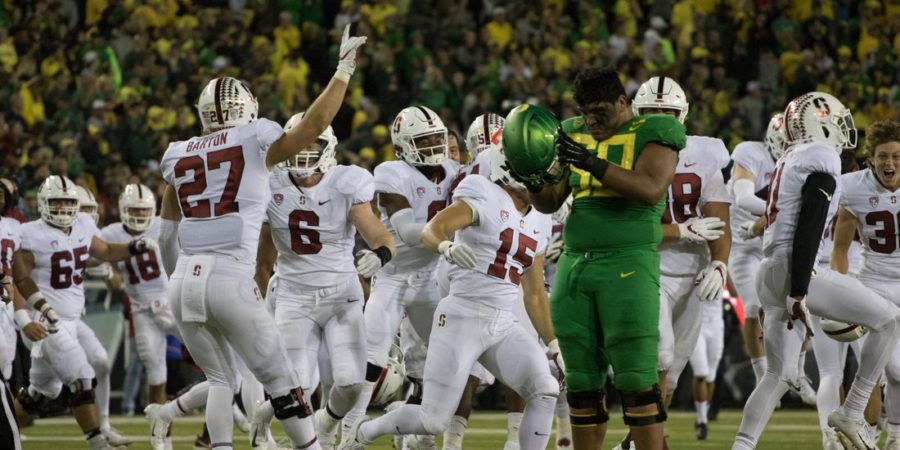How do you make sense of the nonsensical?
How do you explain that which is inexplicable?
These are the questions we’re left to ponder in the aftermath of Oregon’s emotionally gutting 38-31 loss to Stanford on a day and a night that was unfolding to perfection for the 20th-ranked Ducks – until it wasn’t.
All it takes is one look at Saturday’s box score in order to understand a story that wildly contradicts the game’s final score.
For further proof that speaks to the improbability of Oregon’s loss, consider ESPN’s win probability index during the game, which showed that the Ducks had a 99% chance of earning the victory with 4:40 left in the third quarter.
Then, an unconscionable domino affect of events occurred that definitively altered the outcome of the game, and perhaps the season, for Oregon.
Below, WFOD takes closer look at the game and reveals it’s final thoughts and takeaways the day after Oregon’s heartbreaking defeat to Stanford.

1. Sometimes, sh*t happens
It may sound like an oversimplification of what occurred for the Ducks Saturday night versus Stanford, but in a game that appeared destined to get out of hand in late in the third quarter with the Ducks holding a commanding lead deep in Stanford territory, it’s really the best way to summarize everything that transpired. It began with a perplexing referee decision to overturn Jaylon Redd’s 17-yard touchdown run after it was determined that Redd knocked over the pylon and stepped out of bounds before the ball crossed the goal line. The score would have given the Ducks a 31-7 lead, but instead gave Oregon the ball 1st and goal from the Stanford 1-yard line. The ensuing play saw Justin Herbert and Cyrus Habibi-Likio flub a handoff that resulted in a 10-yard loss. Two plays later, an errant snap from center Jake Hanson (one of a handful of wild snaps on the day for the typically steady veteran) went over the head of Herbert and was recovered by Stanford’s Joey Alfieri who raced 80 yards for the score to cut Oregon’s lead to 24-14.
The 14-point swing radically flipped momentum in favor of the Cardinal, as an Oregon three-and-out on the following series was countered by a lightning quick three-play Stanford scoring drive that narrowed the Ducks’ lead to 24-21. Oregon would engineer an 11-play, 70-yard touchdown drive to extend their lead to 31-21, but Stanford was once again quick to march down the field for another touchdown, returning the ball to the Ducks with a 31-28 lead with 3:10 left in regulation. A composed drive that moved the chains was all Oregon would need to bleed Stanford of their timeouts and win the game. However, a fumble by Oregon running back CJ Verdell as he extended for the first down marker was recovered by Stanford with 51 seconds left, allowing enough time for the Cardinal to get into field goal range to successfully send the game into overtime.
There can be no disputing the fact that Oregon had their opportunities to close out the game, but every fortunate bounce of the ball that Stanford needed to win the game, they received, and capitalized on in kind. Coaches, players, and fans always play the woulda/coulda/shoulda game in the aftermath of devastating losses, but the unexpected result of a game can sometimes be the result of the football gods simply smiling favorably upon a given team on a given day.
2. A tough lesson was learned in how to close out a game
While there may have been no shortage of unfavorable bounces that the Ducks received Saturday, there will also be no shortage of self-reflection for Ducks coming out of this heartbreaking loss. Topping the list of plays the Ducks wished they had back was botched snap by Hanson and the fumble late in the fourth quarter by Verdell. In the case of Hanson, the bad snap that directly resulted in a Stanford touchdown was just one of a handful of inexplicably poor snaps the redshirt junior had on Saturday. A leader of the Oregon offensive line, Hanson’s inconsistent play was atypical of the way he has performed while at Oregon. Smart money is on Hanson bouncing back and returning to form in the weeks ahead, but it was one example of how critical it is to execute on even the most routine plays.
The same can be said for Verdell, who led the Ducks with 115 yards rushing on 20 carries but was victimized by poor ball security on Saturday. The fumble that ultimately led to Stanford tying the game at the end of regulation will underscore Verdell’s performance, but he had another fumble that was overturned in favor of Oregon after replay determined his knee was down prior to having the ball knocked loose by a Stanford defender. There’s a lot to be excited about when it comes to the redshirt freshman, but Saturday’s game will be a cautionary tale for him and the rest of the team when it comes to the importance of ball security.
3. The Ducks are a different team in the trenches
Craziness of the game aside, what’s crystal clear is that the Ducks are a totally different team in both the offensive and defensive trenches this year. Last week we were pretty critical of the Oregon offensive line’s performance against San Jose State, but it appears that was simply an aberration, as the Ducks not only brought the fight, but dominated the Stanford front seven for the better part of the game. Led by Verdell’s 115 yards, Oregon gained 178 yards on the ground and were outstanding when faced with converting first downs in short yardage situations. And though Herbert was sacked four times, you likely won’t find too many complaints about pass protection, as the Ducks’ veteran group upfront was largely consistent in giving Herbert a clean pocket with which to operate.
Defensively, the Ducks were perhaps even more impressive with the work they did in the trenches. Against arguably the nation’s best running back in Stanford’s Bryce Love, Oregon did a tremendous job of bottling up last season’s Heisman runner-up, limiting him to 89 yards on 19 carries, with his longest run coming on a 22-yard touchdown scamper late in the third quarter. The defense’s tremendous performance against Stanford’s power running scheme was typified by sophomore nose guard Jordon Scott, who was seen getting routine push into the Stanford backfield to disrupt plays and help the Ducks’ control the line of scrimmage. As long as health permits along the offensive and defensive lines, expect the Ducks to continue trending way up in this area.
4. The Ducks may have issues in the secondary
As good as Oregon’s front seven looked on Saturday, the secondary was arguably as bad in their efforts defending against Stanford quarterback K.J. Costello and the Cardinal passing attack. Coming into the game, there were no secrets as to how Stanford wanted to exploit the size advantage of their receivers and tight ends over Oregon’s defensive backs. And exploit it they did, as wide receiver JJ Arcega-Whiteside (four catches, 84 yards, two touchdowns) and tight ends Kaden Smith (six catches, 95 yards) and Colby Parkinson (three catches, 50 yards, one touchdown) were targeted early and often by Costello, who finished the game completing an impressive 73% of his passes for 327 yards and three touchdowns.
Oregon cornerbacks Thomas Graham and Deommodore Lenoir were the primary victims Saturday and showed very little resistance in their attempts to stifle Stanford’s efforts through the air. It’s true that there are few teams the Ducks will face that have the number of unavoidable matchup problems that Stanford presents, but nonetheless, Oregon’s play in the secondary accurately reflected their updated ranking as the nation’s 97th-best team (out of 130) in defending the pass through four weeks (251.3 yards/game). Playing in a pass happy conference, this is an area that will continue to be exploited by opponents until proven otherwise.
5. Justin Herbert was and is absolutely fantastic
Oregon wide receiver Dillon Mitchell said it best when asked after the game how he would assess Justin Herbert’s performance versus Stanford, “[He played] like the [no. 1 overall] NFL Draft pick.” In a game that will be forever remembered for everything that went wrong for Oregon in the second half, what will be lost in the discussion was Herbert’s masterful command and execution of the Oregon offense.
Though he only accounted for one touchdown Saturday night, Herbert was essentially perfect all the way up until overtime when five of his seven incompletions came on the final series of the game. Herbert would finish the day completing 26-of-33 passes for 346 yards and one touchdown (to go along with one interception), in addition to gaining 35 yards on the ground. Credit too to Oregon offensive coordinator Marcus Arroyo and his offensive staff for devising a game plan that was both appropriately aggressive and easily executable, particularly early on. The diversity of the play calls, along with the timing, was something that wasn’t consistently seen through the three previous games, and an encouraging development for this team as they head out on the road next week vs. Cal.
Herbert with another strong performance, going 26-of-33 for 346 yards and a touchdown. #GoDucks pic.twitter.com/veANtqWhCb
— Oregon Football (@oregonfootball) September 23, 2018
6. Dillon Mitchell had quite the coming out party
After he was conspicuously uninvolved in the Ducks’ offensive game plan against Bowling Green, Portland State, and San Jose State, Mitchell almost single-handedly supported the Ducks in the receiving department versus Stanford, reeling in 14 passes for a career-high 239 yards. Aside from the overtime period where Mitchell was blanketed on three consecutive targets by Stanford’s Paulson Adebo, the Memphis native’s connection with Herbert throughout the game was near flawless, as the two exhibited a synchronicity that hasn’t been seen since Samie Parker’s 16-catch outing versus Minnesota in the 2003 Sun Bowl. His emergence as a true no. 1 wide receiver in this game bodes very well for the Oregon offense moving forward.
News and notes:
- After the game, Oregon senior Taj Griffin tweeted that he would be leaving the program to seek out other options. A highly-touted recruit from Oregon’s 2015 recruiting class, Griffin never seemed to find consistency after an impressive true freshman season that saw him finish fourth on the team in all-purpose yards that season. Injuries and position changes had much to do with Griffin’s limited contributions over the years, but he remained as one of the most explosive players on offense for the Ducks. Having never used a redshirt and after appearing in only three games for the Ducks this season, Griffin will be able to transfer while still preserving a year of eligibility per new NCAA legislation.
- The Ducks’ 24 first-half points were more total points than Stanford gave up in its first three games. Additionally, Oregon’s touchdowns on each of its first two possessions marked the first time Stanford had given up points in back-to-back drives this season.
- The Oregon defense is holding opponents to 1.8 yards per carry in the last two games (166 yds, 92 att.) and 2.3 yards per carry in last five games (512 yds., 225 att.) dating back the Oregon State game last year.
- Justin Herbert has the most passing yards through 21 career games at Oregon with 5,105, good for 147 more than Marcus Mariota (4,958). Saturday was also the first time in his career that he’s thrown for over 300 yards in back-to-back games.
- Justin Hollins extended his streak of consecutive games with a sack to five, which is only behind Ohio State’s Nick Bosa (6), who did not play on Saturday.
- Dillon Mitchell’s 239 yards are the second-most receiving yards in a single game in school history. Only Tony Hartley’s 242 vs. Washington on Nov. 1, 1998 stands above Mitchell’s performance.

